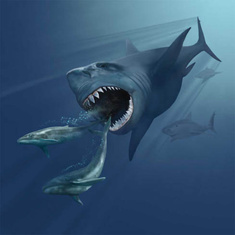
Prehistoric Fish
First published: Thursday August 12th, 2021
Report this blog
Haikouichthys
Haikouichthys was a genus of jawless fish that existed during the Cambrian period. It was one of the earliest animals to have both a notochord and a distinct head, along with related genera such as Myllokunmingia. As one of the earliest fish, it lacked jaws, and is believed to have been related to modern lampreys and hagfish. It reached 2.5 centimetres in length.
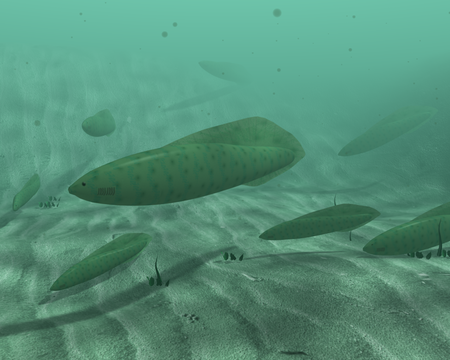
Astraspis
Astraspis was another genus of jawless fish, which existed during the Ordovician period. Like other fish of the class Pteraspidomorphi, it was covered in plates, with smaller plates covering the tail and larger plates covering the head. It grew to 20 centimetres in lenght, and had star-shaped tubercles covering the plates, giving the animal its name (Astraspis means "star-shield").
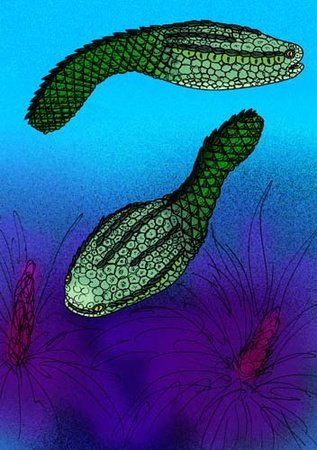
Megamastax
The first jawed fish appeared in the Silurian period. One of these was the lobe-finned fish Megamastax, considered to be the largest known vertebrate from that time at around one metre in length. It had two rows of small marginal teeth and a row of large blunt teeth, an arrangement unique among early jawed fish.
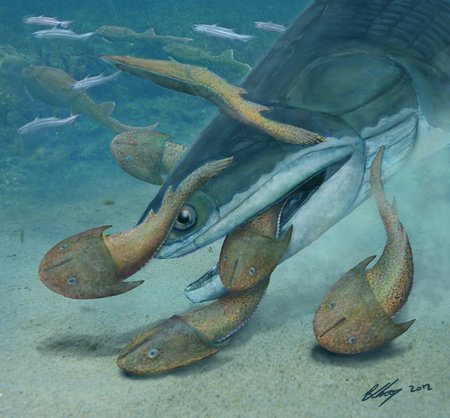
Cheirolepis
Though ray-finned fish first appeared during the Silurian, the genus Cheirolepis, which evolved during the Devonian, is considered the first to possess the dermal bones seen in later ray-finned fish. It was a predator that lived in freshwater and estuaries, reaching 55 centimetres in length. Its well-developed fins gave it speed and stability when hunting, and the size of its eyes suggests that it hunted by sight. Its jaws could be opened wide, allowing it to swallow prey nearly as large as itself.
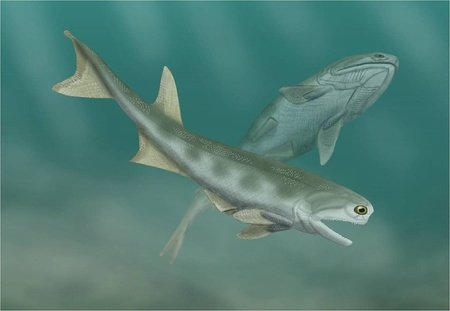
Acanthodes
Acanthodians were another type of early jawed fish, having first evolved during the Silurian. They are sometimes called spiny sharks, though they were only a close relative to modern sharks. The genus Acanthodes first appeared during the early Devonian period and existed until the early Permian. It was larger than most other spiny sharks at 30 centimetres in length, and had no teeth, suggesting that it may have been a filter feeder.

Cladoselache
Cladoselache was a genus of shark-like cartilaginous fish from the Devonian. It grew up to 1.8 metres in length and was a predator. It had strong jaw-closing muscles yet had a weak jaw joint, as well as teeth that were suited to grasping prey, suggesting that it grabbed prey then swallowed it whole. It had only a small number of scales, and had powerful keels, giving it speed and agility. It is thought that its main predator was the next fish on this list.
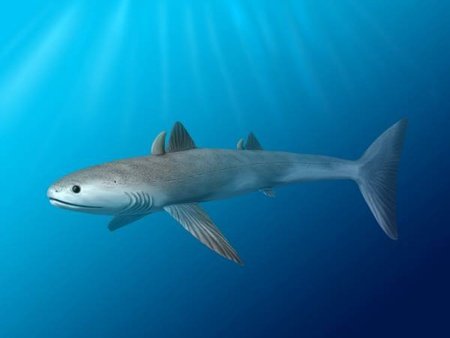
Dunkleosteus
The placoderms were another group of jawed fish that evolved during the Silurian. Like fish of the class Pteraspidomorphi, placoderms had armoured heads, and they were the first fish to develop pelvic fins. Dunkleosteus was a genus which included some of the largest placoderms and as such some of the largest animals alive at the time. Dunkleosteus terrelli, the largest species, grew up to 8.79 metres long and weighed up to 4 tonnes. Its mouth contained two pairs of sharp bony plates instead of teeth, and it had the ability to open and close its jaws quickly: this allowed it to suck prey into its mouth, after which it delivered a bite with a force ranging from 6,000 to 7,400 newtons.
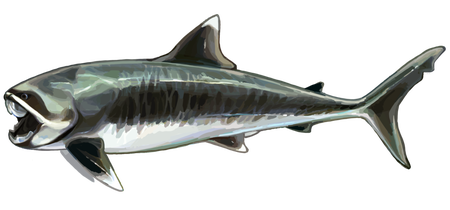
Titanichthys
This genus of placoderms includes species that grew to around the same size as Dunkleosteus. It is thought to have been a filter feeder, feeding on small fish or zooplankton, and had small mouth-plates. These plates would have helped to retain the prey while the animal closed its mouth, so as to remove the water inside. As such, it was the earliest known large-sized vertebrate filter feeder.
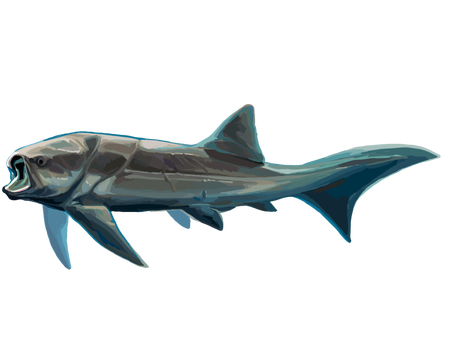
Hyneria
The previous two fish both lived in the oceans, yet there were also large fish living in freshwater during the Devonian. Hyneria was a genus of predatory lobe-finned fish that grew to between 2.5 and 3.7 metres in length. It had heavy dermal bones and a long and shallow lower jaw. It had stout teeth, along with fangs that reached 5 centimetres in length, as well as large sensory canals that helped it detect prey in the murky water.
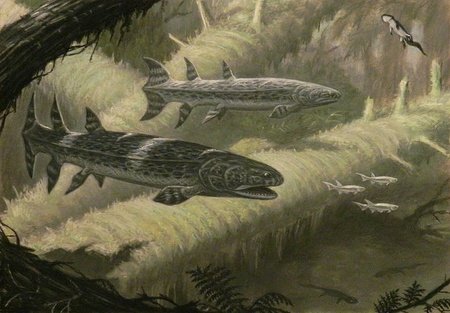
Panderichthys
The first terrestrial vertebrates evolved from lobe-finned fish, during the late Devonian period. Although Panderichthys is not thought to be a direct ancestor of tetrapods, it had features that show the transition between lobe-finned fish and early tetrapods. For instance, it had a humerus that was almost L-shaped (tetrapods have L-shaped humeri). It also had finger-like bones at the end of its limbs and lacked dorsal and anal fins. Its skull and tail were both similar to those of early tetrapods, and it had the ability to breath air. Species of Panderichthys reached between 90 and 130 centimetres in length.
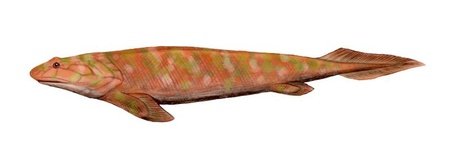
Tiktaalik
Tiktaalik, another lobe-finned fish alive during the late Devonian, represents the transition between fish like Panderichthys and early tetrapods, and is a possible common ancestor of all terrestrial vertebrates. Like Panderichthys, it had a flat triangular head and the ability to breath air, but unlike Panderichthys it had weight bearing fins, allowing it to prop itself up in shallow water and support itself on land. A strong ribcage helped support the animal's body while on land, and it was the first known fish to have a neck, which aided it when hunting.
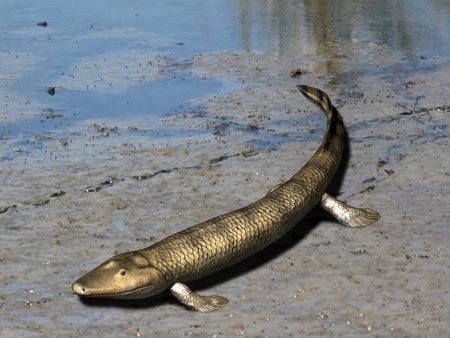
Stethacanthus
Stethacanthus was a genus of shark-like cartilaginous fish, related to modern chimaeras, which existed from the late Devonian to the late Carboniferous. The fish grew to 70 centimetres long, and had an unusual dorsal fin topped with small spikes. There are several theories as to its purpose: it may have been used during mating rituals or to attach the fish to larger animals, or it could have been used to frighten off predators. The strange fin would likely produce a drag force if the shark was a fast swimmer, suggesting that it was instead slow-moving.
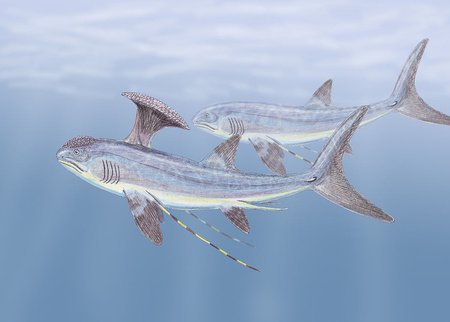
Edestus
The Eugeneodontida were an order of fish that belonged to the subclass Holocephali; they were related to Stethacanthus and modern chimaeras. They were unusual due to the fact that they had "tooth-whorls" within their jaws. For example, the Carboniferous fish Edestus had a single row of teeth in the midline of each jaw, an arrangement often compared to scissors. Teeth would grow at the back end of each whorl, would move forwards throughout the animal's lifetime and would eventually fall out at the front. There have been many hypotheses suggesting how the whorls worked, including one suggesting that they would be used to grasp and slice soft bodied prey. E. heinrichi was the largest species, thought to reach lengths greater than 6.7 metres (which is around the same size as the largest great white sharks).
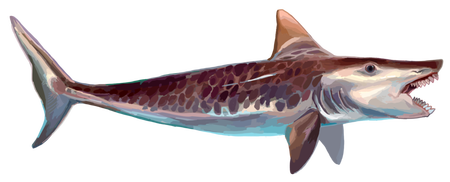
Helicoprion
Helicoprion is probably the most famous eugeneodont. The genus lived during the Permian period, and is estimated to have reached lengths of up to 8 metres, making it the roughly same size as modern basking sharks. Helicoprion's tooth whorl was spiral-shaped, with new teeth forming in the centre. Like Edestus, Helicoprion likely hunted soft bodied prey, such as nautiloids and ammonoids: the front teeth caught prey and dragged it into the mouth, where the middle and hind teeth punctured it and brought it further into the throat. The prey would then be squeezed between the whorl and the roof of the mouth.
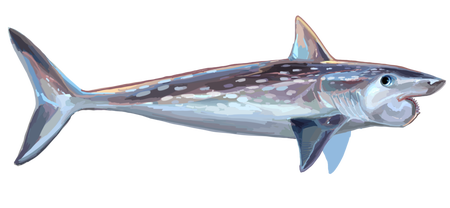
Hybodus
Hybodus was a genus of shark that existed from the late Permian to the late Cretaceous. Along with other hybodonts, Hybodus was especially successful throughout the Mesozoic Era and could be found in shallow seas throughout the world. As they had two different types of teeth, they are thought to have had a wide diet and were likely opportunist predators. They were streamlined and had two dorsal fins, making them fast and agile, and they had a bony plate on their dorsal fin, which was likely a defensive feature. Hybodus males had claspers, which are organs used in mating; modern sharks also possess them. The largest Hybodus species grew to around 2 metres in length.
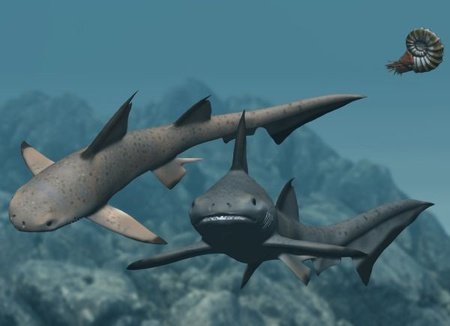
Saurichthys
Saurichthys was a genus of ray-finned fish alive during the Triassic. It resembled the modern pike, yet its closest living relatives include bowfins, sturgeons and paddlefish. Species of Saurichthys lived in both the oceans and freshwater, and ranged in size from under a metres to 1.5 metres in length. They likely hunted by ambushing prey at high speed and often fed upon their own kind.
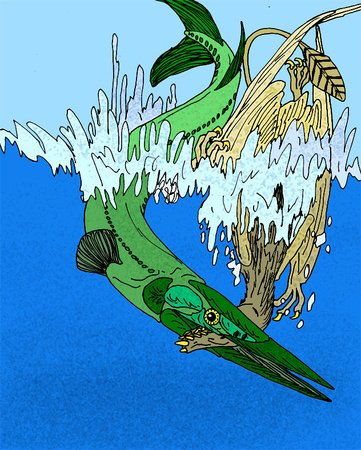
Leedsichthys
Leedsichthys, which lived during the Jurassic period, is the largest known ray-finned fish; one individual is thought to have reach a body length of 16.5 metres. As the animal's skeleton consisted of both bone and cartilage, the fossils found so far are fragmented, which makes it a difficult animal to study. One species was named L. problematicus because of this. What is known is that, like the largest fish species today, Leedsichthys was a filter feeder, catching plankton and small animals in gill rakers. It had large and incredibly long pectoral fins, but lacked pelvic and anal fins. The fish was capable of swimming as fast as 11 mph.

Mawsonia
Coelacanths first appeared in the early Devonian and still exist today. The largest species to ever exist belonged to the genus Mawsonia, the largest growing to 6.3 metres long. The genus existed during the late Jurassic period and into the Cretaceous. The fish had six fins and had 1-2 millimetre denticles instead of teeth. It was one of several species of large fish preyed upon by Spinosaurus.
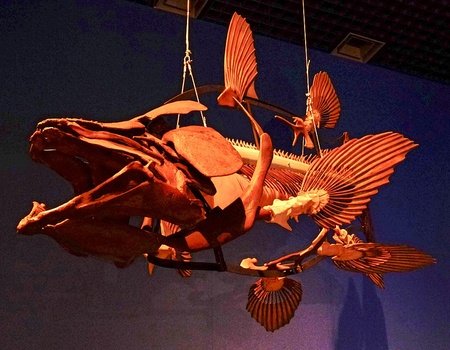
Protopsephurus
Protopsephurus was a genus of paddlefish that existed during the early Cretaceous and grew up to seven metres in length. It lived in what is now China, and swam along the bottoms of rivers and estuaries, eating plankton and small fish.

Enchodus
Enchodus was a genus of ray-finned fish related to modern lancetfish and lizardfish. It first appeared during the Cretaceous, and unlike many other animals it survived the Cretaceous–Paleogene extinction event, only becoming extinct 37.2 million years ago. The largest species, Enchodus petrosus, grew to 1.5 metres long. Like lancetfish, Enchodus was a predator with large fang-like teeth on the upper and lower jaws, a long body and large eyes. Fossils of Enchodus have been found around the world, including within the stomachs of larger predators.
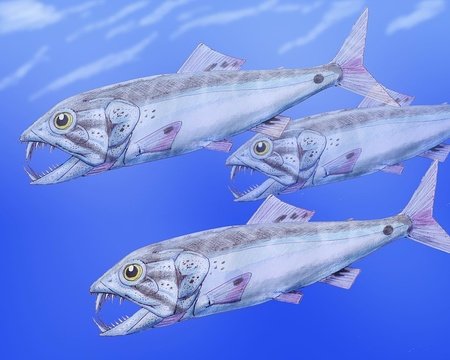
Xiphactinus
Xiphactinus was one of the largest fish alive during the Cretaceous, growing to 5.1 metres long. It fed on large prey: a fossil of a 4 metre long individual was found with a 1.8 metre long Gillicus arcuatus (a close relative) inside it. The smaller fish likely killed the Xiphactinus while inside. Xiphactinus may have been able to reach speeds of up to 37 miles per hour, according to some estimates. Fish within the same subfamily, such as the 4 metre long Ichthyodectes, also grew to large sizes.

Ptychodus
The oceans of the Cretaceous were home to several large species of shark, with Ptychodus being one of the largest, growing up to 10 metres in length. Twenty-three species of Ptychodus have been discovered across all continents. It largely fed on animals such as large bivalves and crustaceans living on the sea floor, though it also fed on carrion. To get through the shells of its prey, it had up to 550 large crushing plate teeth, the largest measuring 55 by 45 centimetres. It faced very little competition, as it mainly had its food source to itself; it also lived in an area separate to the territories of other large sharks.

Squalicorax
Squalicorax was a genus of mackeral shark (an order which includes the great white) alive during the Cretaceous, that grew up to five metres in length. It had a body similar to that of a grey reef shark, yet its teeth were very similar to those of a tiger shark. It was a coastal predator: it fed on mosasaurs, fish and turtles but also scavenged dinosaur carcasses. Thirty-three species have been discovered, as well as two subspecies.
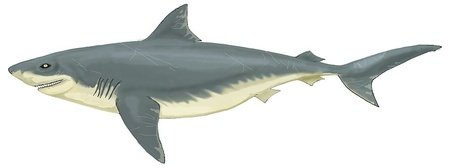
Cretoxyrhina
Another mackeral shark from the Cretaceous, species of Cretoxyrhina measured up to 8 metres in length and weighed over 4,944 kilograms. It had an appearance similar to a great white, and being an apex predator it preyed on a great variety of animals, including marine reptiles, sharks and other fish, pterosaurs and the occasional dinosaur. It had 8 centimetre long razor-like teeth built for stabbing and slicing, and could swim at 43 miles per hour in bursts. In addition to its similar appearance, it may have hunted in the same way as a great white, lunging at prey. The four species of Cretoxyrhina lived in all the world's oceans at the time.
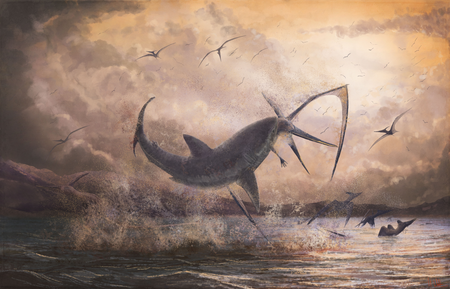
Atlanticopristis
Atlanticopristis, a genus containing one species, was one of many sawfish-like cartilaginous fish belonging to the family Sclerorhynchidae. Its long snout was lined with teeth-like scales with barbs on each side, which it would use to sift through mud and sand, or to slash at prey. It lived in estuaries located near conifer forests in the Cretaceous, alongside other large fish such as the closely related Onchopristis and the coelacanth Mawsonia. Atlanticopristis, alongside those two other fish genera, was hunted by crocodilians and dinosaurs such as Spinosaurus.
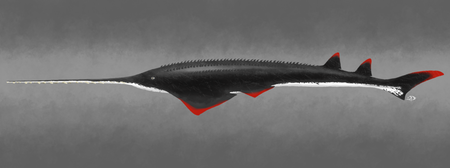
Aquilolamna
Aquilolamna was a genus of fish that existed during the late Cretaceous. It was a cartilaginous fish, and may have been a type of mackeral shark. Its unusually long fins were, when measured tip to tip, wider than the animal was long. It may have been a filter feeder and as such may have gone extinct due to a decline in plankton populations.
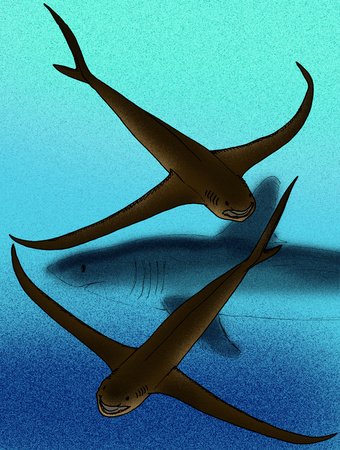
Protosphyraena
Protosphyraena lived during the late Cretaceous and resembled a swordfish, though it was not closely related. One of the main differences is that Protosphyraena was smaller than modern swordfish, the largest species only reaching 3 metres in length. It also had a smaller rostrum, was less hydrodynamic and had teeth, which is something that swordfish lack.
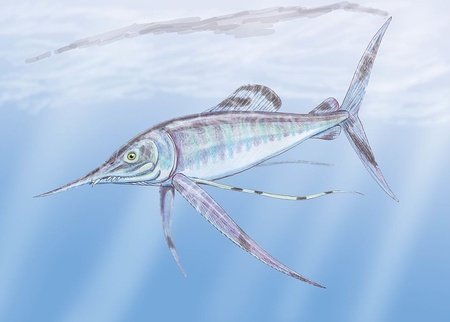
Bonnerichthys
Although Leedsichthys only lived during the Jurassic, related genera such as Bonnerichthys existed during the Cretaceous. Bonnerichthys appeared partway through the period and was one of many animals to go extinct during the Cretaceous–Paleogene extinction event. It grew to around 6 metres in length, and like its larger, earlier relative, it was a filter feeder.
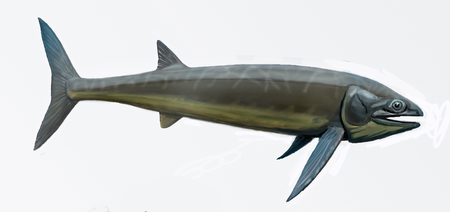
Megalodon
Megalodon, likely the most famous animal on this list, was a massive species of mackeral shark that existed during the Miocene and Pliocene. It may have been the largest fish to ever exist, but like Leedsichthys its remains are fragmentary, and as such the size of the animal is difficult to determine. Maximum length estimates range from 14.2 to 20.3 metres. It may have had an appearance similar to a great white, though in addition to the size difference it belonged to a different family of sharks (the great white is part of the Lamnidae family while the megalodon belonged to the family Otodontidae). Other sharks that it may have resembled include the whale shark, the basking shark and the sand tiger shark.
During a 2008 experiment, a team of scientists measured the bite force of a great white and calculated the bite force of megalodon based on the results. The team placed the bite force of megalodon between 108,514 to 182,201 newtons, compared to the 18,216 newtons bite force of the largest confirmed great white. Megalodon could survive in a wide range of environments, moving between coastal and oceanic waters and surviving in colder regions by maintaining a higher body temperature than the surrounding water (this is called mesothermy, and other large sharks are able to do it). Megalodon living in the Southern Hemisphere were typically larger than those in the Northern Hemisphere, and megalodon living in the Pacific were larger than those in the Atlantic.
Due to their size, megalodon were apex predators, and their diet consisted of a great variety of cetaceans, though they also ate seals, sirenians, turtles and fish. Similar to how great whites hunt, megalodon often attacked its prey from below with immense force; however, while great whites target the underbelly, megalodon likely targeted the heart and lungs. Besides others of its own kind, megalodon probably competed with large predatory whales such as Livyatan.

Sabretooth Salmon
This species of salmon lived along the Pacific coast of North America during the Miocene and Pliocene, and had some similarities to modern salmon as well as some differences. At 2.29 metres in length, it was the largest member of its genus, which also includes modern species such as the sockeye salmon. They also differed from their modern relatives by having small fangs on their snouts and by having larger gill rakers. However, like modern salmon, they are thought to have migrated upriver to spawn.
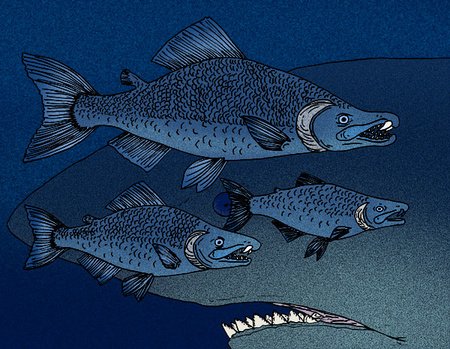
Megapiranha
The megapiranha, as the name suggests, was slightly larger than modern piranhas at 71 centimetres in length and 10 kilograms in weight. For comparison, the largest extant piranha, the piraya piranha, grows to 50 centimetres in length in the wild. It had an estimated bite force between 1,240 and 4,749 newtons and was alive during the late Miocene period.
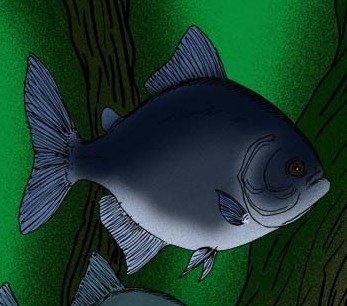

Great blog!